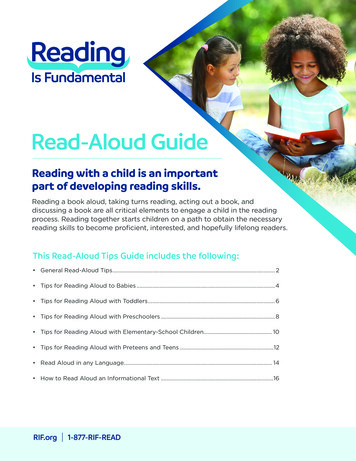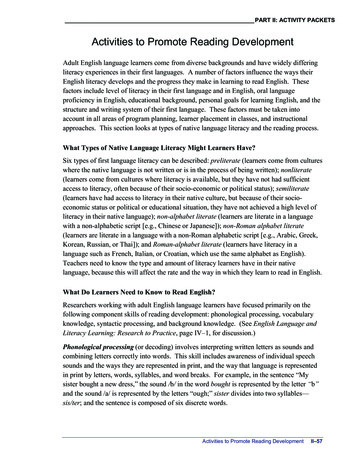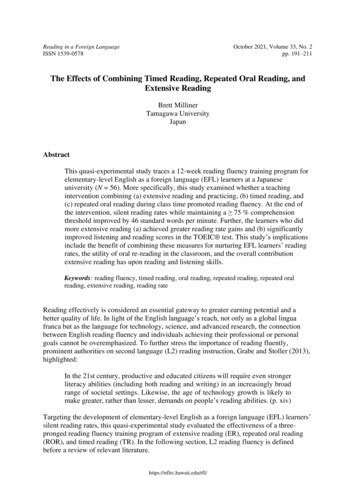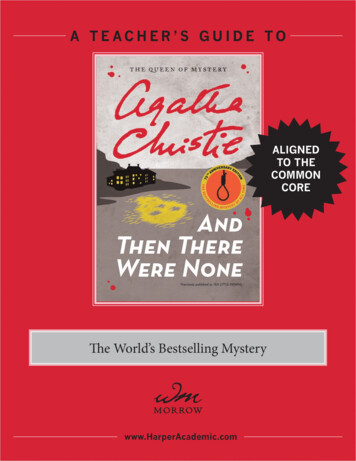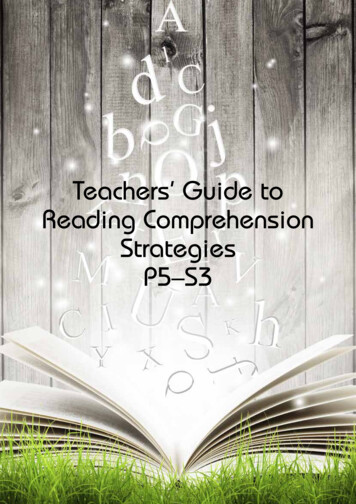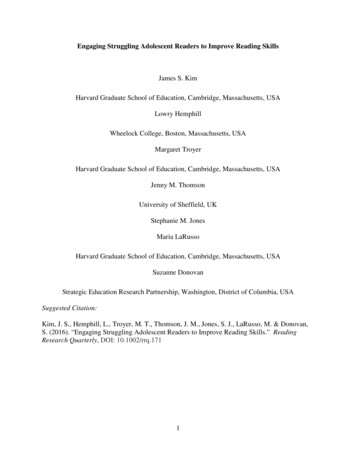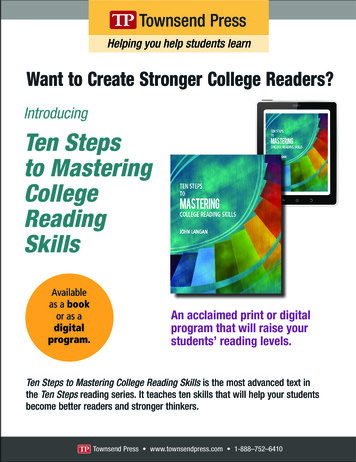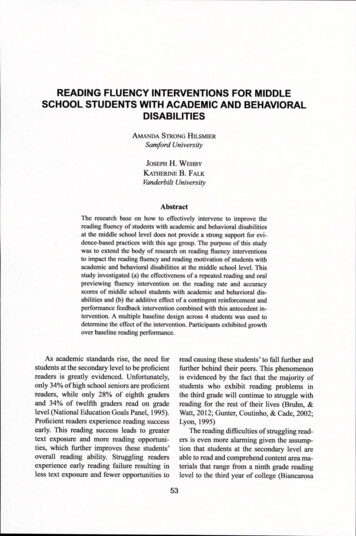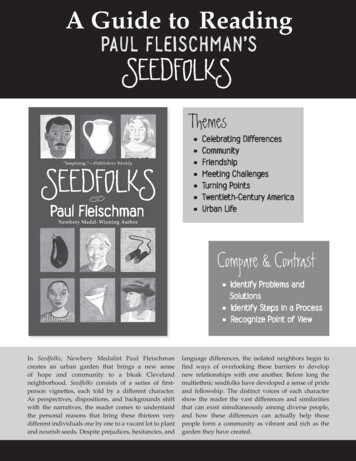
Transcription
A Guide to Readingpaul fleischman’sThemes Celebrating DifferencesCommunityFriendshipMeeting ChallengesTurning PointsTwentieth-Century AmericaUrban LifeCompare & Contrast In Seedfolks, Newbery Medalist Paul Fleischmancreates an urban garden that brings a new senseof hope and community to a bleak Clevelandneighborhood. Seedfolks consists of a series of firstperson vignettes, each told by a different character.As perspectives, dispositions, and backgrounds shiftwith the narratives, the reader comes to understandthe personal reasons that bring these thirteen verydifferent individuals one by one to a vacant lot to plantand nourish seeds. Despite prejudices, hesitancies, andIdentify Problems andSolutionsIdentify Steps in a ProcessRecognize Point of Viewlanguage differences, the isolated neighbors begin tofind ways of overlooking these barriers to developnew relationships with one another. Before long themultiethnic seedfolks have developed a sense of prideand fellowship. The distinct voices of each charactershow the reader the vast differences and similaritiesthat can exist simultaneously among diverse people,and how these differences can actually help thosepeople form a community as vibrant and rich as thegarden they have created.
Reading Skills and StrategiesBefore ReadingAlthough the characters inSeedfolks live in the sameneighborhood, most of themnever bothered to introducethemselves until they startedseeing one another at the garden.Have students think about theirown neighborhoods. What doesit mean to be neighbors? Whatare their relationships withtheir neighbors? What are somethings that could potentiallyturn a neighborhood into acommunity? Do they think thattheir neighbors would welcomean opportunity to get to knowone another better?Challenging IssuesSeedfolks deals with certainissues that might be difficult forsome students to discuss in theclassroom, such as teen pregnancyand drugs. Keeping the focus onthe novel’s characters and theirsocial context rather than onstudents’ personal experiencescan make it easier for the class todiscuss these issues.When discussing Maricela, thecharacter introduced on page52, students should recognizethat she is angry with herselffor the situation into which shehas gotten herself. On page 5,be sure students recognize that“Negro” was the name used forAfrican Americans during thetime period (the Depression)being discussed.Compare and ContrastEach character in the book has adistinct background and reasonsfor coming to the garden. Selectfive characters from the book.For each character consider thefollowing: What is the character’sethnicity? What plant does thecharacter choose to grow, andwhy? What brings this characterto the garden? What does thecharacter gain from participatingin the planting of the garden?Address these questions inthe form of a chart, with thecharacters’ names down the sideand the questions across the top.Fill in the chart with the class asyou read.Identify Problemsand SolutionsIn Seedfolks, the gardenersencounter the problem of gettingwater to their plants. How doesthe group work together tosolve this problem? What otherproblems come up throughoutthe book, and how are they dealtwith? What problems do youthink the garden might face inthe future?Identify Steps in a ProcessIn the course of the book, thesmall garden turns isolatedneighbors into a community.As students read, have themidentify the steps that leadto this unexpected outcome.Make a poster-sized diagramof this process, and update itas you read.Recognize Point of ViewAsk students to think abouthow the author gave each ofhis characters a distinct voice.Describe some of the waysFleischman distinguishes thecharacters by how they telltheir stories. How does the wayin which characters presenttheir stories help convey theirpersonalities to the reader?Recall an example of whenthe same event is describedby two different characters.How do their depictionsdiffer? What factors may havecontributed to the characters’different perspectives?
Sharing the BookQuestions for Group Discussion1. How does the garden itself become a metaphorfor what happens among its members?2. Kim starts the garden without even realizing it.How does she do this? What are her reasons forplanting lima bean seeds?3. What does Ana assume about Kim when shesees her burying her seeds? How does she feelwhen she realizes her error?4. On page 13 Gonzalo says, “The older you are,the younger you get when you move to the UnitedStates.” What does he mean by this?5. How does Leona affect the course of the narrative?How does she use the garbage from the lot toher advantage?6. List some of the problems that the gardenersencounter. How do they help one another deal withthese obstacles?7. Describe Sae Young’s traumatic experiencesin America. How does the garden help herovercome them?8. Curtis tries to change his ways as he woosLateesha with the tomatoes. What is he trying toshow Lateesha about his values and principles?9. In the course of the novel, a homeless young mannamed Royce comes to live in the garden. Describehow the gardeners’ attitudes toward Royce change.How do they help Royce, and how does he helpthem in return?10. Why does Penny think working in the gardenwill be good for Maricela? How does it get Maricelato think differently?11. What does Sam observe about how the gardenis set up? How does he feel about this?12. Sam likes to spend his time “sewing up therips in the neighborhood.” What are some of theways he does this in the garden? What are some ofthe things he does that many other people neverbothered doing? Why do you think this approachhelps him get through to people?13. On page 59 Amir says that “the garden’s greatestbenefit, I feel, was not relief to the eyes, but to makethe eyes see our neighbors.” What does he mean?Give some examples.14. What does Florence mean by the word“seedfolks”? Why do you think the author chosethis as the title for the book?15. What are some of the stereotypes Amir has aboutPolish people, and how does his attitude changewhen he meets one? What does this demonstrateabout passing judgment?16. What are some of the ways in which thecharacters work around language barriers tocommunicate?
Language ArtsHave students take the role of a“seedfolk” and write their ownvignette to add to this collection.Just as Fleischman gives eachof his characters a distinctbackground, voice, and set ofproblems, have students developsuch factors in their own stories.Make copies of the class’s stories,collate them, and distribute themto the class as a book entitled[Your name]’s Seedfolks.Social StudiesThe characters in Seedfolkscome from a variety of differentcountries. Have students locatethese places on the map. Havesmall groups of students choose acharacter and research the historyand economy of that character’scountry of origin. Then have eachgroup prepare a report on thatcountry, focusing on the factorsthat may have led people toemigrate to the United States.Seedfolks takes place in a poorsection of Cleveland, Ohio, witha transient population. As Anasays on page 5, “You stay untilyou’ve got enough money toleave.” Creating the garden,however, not only brings beautyto the neighborhood, but also asense of pride and community.Using research and theirimaginations, have students thinkabout other ways to boost moraleand pride in the neighborhoods.Have them share these ideas inposters with the class.As a class, adopt an area inyour neighborhood to fix up.If it’s not possible to plant agarden in the space, refer to themorale-boosting activities thatstudents come up with and makeyour adopted space somethingof which the neighborhood canbe proud.ScienceMaricela is instructed to growplants in the garden to learn howit feels to take care of somethingliving. Have students grow theirown lima bean seeds. Have themkeep a journal of the plants’progress and their responsibilitiesin taking care of them. Limabeans develop quickly, so havestudents chart the beans’ growtheach day. Monitor progress andgrowth, and compare results.If a plant doesn’t make it,review the journals and try tofigure out why. At the end ofthe project, have the studentssummarize what they did andhow they dealt with unexpectedcomplications. Periodically, havestudents discuss their progress.This is a good opportunity forclassmates to help one anothersolve problems or complicationsthat arise with plant growth.ArtHave each student design ajacket for the book. Before theystart, brainstorm with the classthings to consider in designinga book jacket, such as makingit eye-catching, finding creativeways to convey what the book isabout, and deciding the people towhom this jacket should appeal.Hang the book jackets aroundthe room.DramaChoose a volunteer to select acharacter from the book andimpersonate that character. Havethe student come to the frontof the room, in character, andanswer questions posed by otherclassmates. Repeat for othercharacters with other volunteers.If you have more volunteers thancharacters, consider some of thecharacters who do not narrate,such as Lateesha, Royce, orVirgil’s father. Prepare studentsfor the activity the day beforeso that they will have some timeto think of questions for thevarious characters.
Questions for Paul FleischmanPhoto by Dana FleischmanHow did you choose the title?Seedfolks is an old word for ancestors. I’d come acrossit somewhere in my reading and had planned to useit for a very different book—interviews with firstgeneration immigrants who’d planted their familiesin the United States. It’s a subject close to me, havingtwo sons adopted from Mexico.Where did the idea for Seedfolks come from?In a place where many of my books have started:the newspaper. I spotted an article about a localpsychologist who used gardening as a therapy forher clients. I’d been looking for a setting that wouldbring a varied cast together. Suddenly, I realizedI’d found one—not the garden in the article, but acommunity garden.Are parts of the book autobiographical?My parents were true plant people, graduallyreplacing the front lawn with fruit trees and evena cornfield. My mother had also volunteered ina garden at a veterans’ hospital, teaching shellshocked soldiers how to raise plants. There’s a littleof her in Nora, the nurse, and a little of me in Sam.Like him, I like to bring people together. I’m also inKim, since my mother had recently died and I waswishing she could read the books I was writing—especially this one.What research did you have to do?I’ve never lived in Cleveland and have never had aplot in a community garden. So I visited gardens, tooknotes, asked questions. I read books on Cleveland,recent immigrants, and gardening. I rememberedthe melting pot neighborhoods I’d lived in Berkeley,Omaha, and Albuquerque. Writers learn how to findout what they need to know.Why did you tell the story from many characters’points of view?I seem to have been born with a multitrack mindand wanted to write music rather than bookswhen I was young. Before Seedfolks I’d written twocollections of poems for two speakers. Then cameBull Run, an account of the Civil War battle fromsixteen characters’ points of view, my attempt atsomething symphonic. That work was the firstuse of the form in novels for children as far as Iknow. It’s now commonplace because of its manyadvantages: Writers get to write in different voices,can show events from different perspectives, and getto present an unpredictable, kaleidoscopic surfaceto their readers.
Best Books for Young Adults (ALA) Quick Picks for Young Adults (ALA) School Library Journal Best Book Publishers Weekly Best Book Notable Children’s Book in theLanguage Arts (NCTE) Buckeye Children’s Book Award(Grades 6–8) Popular Paperbacks for Young Adults(ALA) Jane Addams Book Award Honor Book New York Public Library Books forthe Teen Age New York Public Library’s “One HundredTitles for Reading and Sharing” Children’s Choice (IRA/CBC) Teachers’ Choice (IRA/CBC) Quick Picks for Reluctant Young AdultReaders (ALA) Notable Children’s Trade Books in the Fieldof Social Studies (NCSS/CBC) Golden Kite Award Honor BookVisit the following websites for information on how to start your own community garden, and more! Notable Children’s Books (ALA) Best Books for Young Adults(ALA) Horn Book Fanfare Honor List School Library Journal Best Books ALA Booklist Editors’ Choice Teacher’s Choices (IRA/CBC) Notable Children’s Trade Booksin the Field of Social Studies(NCSS/CBC) Notable Children’s Books in theLanguage Arts (NCTE) Publishers Weekly Best Books New York Public Library’s“One Hundred Titles for Readingand Sharing” Bulletin Blue Ribbon Books(Bulletin of the Center forChildren’s Books) Children’s Books of the Year(Library of Congress) New York Public Library’s Booksfor the Teen Age Golden Kite Award Honor BookThe Half-a-Moon InnIllustrated by Kathryn JacobiPb 0-06-440364-5 4.99 ( 6.50) ALA Booklist Children’sReviewers’ Choices New York Times Notable Booksof the Year Children’s Books of the Year(Library of Congress) Golden Kite Award Honor BookMore titles by Paul FleischmanBull RunLb 0-06-021447-3 16.89 ( 25.89)Pb 0-06-440588-5 4.99 ( 6.50) Notable Children’s (ALA) Best Books for Young Adults (ALA) Best of the Best Books forYoung Adults (ALA) Horn Book Fanfare Honor List School Library Journal Best Books ALA Booklist Editors’ Choices Teachers’ Choices (IRA/CBC) Notable Childrens’ Trade Booksin the Field of Social Studies(NCSS/CBC) Notable Children’s Books in theLanguage Arts (NCTE) Scott O’Dell Award for HistoricalFiction for Children Publishers Weekly Best Books Children’s Books of the Year(Library of Congress) New York Public Library Booksfor the Teen Age New York Public Library’s“One Hundred Titles for Readingand Sharing”I Am Phoenix:Poems for Two VoicesJoyful Noise:Poems for Two VoicesSaturnaliaIllustrated by Joel SpectorIllustrated by Eric BeddowsPb 0-06-447089-X 5.99 ( 7.99)Tr 0-06-021852-5 15.99 ( 23.99)Lb 0-06-021853-3 16.89 ( 25.89)Pb 0-06-446093-2 5.99 ( 8.50) ALA Notable Children’s Book Horn Book Fanfare Honor List School Library Journal Best Book Notable Children’s Trade Booksin the Field of Social Studies(NCSS/CBC) Notable Children’s Books in theLanguage Arts (NCTE) New York Public Library Booksfor the Teen Age New York Public Library’s“One Hundred Titles for Readingand Sharing” Bulletin Blue Ribbon(The Bulletin of the Center forChildren’s Books) Boston Globe–Horn Book AwardHonor Book ALA Booklist Editors’ Choice Newbery Medal Notable Children’s Books (ALA) Best Books for Young Adults(ALA) Boston Globe–Horn Book AwardHonor Book for Fiction/Poetry Horn Book Fanfare Honor List Notable Children’s Books in theLanguage Arts (NCTE) Children’s Books of the Year(Library of Congress) New York Public Library’s Booksfor the Teen Age New York Public Library’s“One Hundred Titles for Readingand Sharing”Joyful Noise andI Am PhoenixUnabridgedCD 0-06-052619-X 12.00 ( 19.00)Time TrainIllustrated by Claire EwartPb 0-06-443351-X 6.99 ( 9.99) School Library Journal Best BookIllustrated by Ken NuttPb 0-06-446092-4 5.99 ( 7.99) Notable Children’s Books in theLanguage Arts (NCTE) Children’s Books of the Year(Library of Congress) New York Public Library Booksfor the Teen Age www.harperchildrens.comFor exclusive information on your favorite authors and artists, visit www.authortracker.com.Prices and availability subject to change without notice. To order, contact your local bookstore or distributor.March 2006The Borning RoomPb 0-06-447099-7 4.99 ( 7.99)Don’t forget to visit Paul Fleischman’s website at www.paulfleischman.netAmerican Community Gardening Association www.communitygarden.orgNational Gardening Association www.garden.org/homeTeacher’s Guide ISBN 0-06-115819-4Tr 0-06-027471-9 14.99 ( 19.99)Lb 0-06-027472-7 15.89 ( 20.89)Pb 0-06-447207-8 4.99 ( 6.50)
How do they help Royce, and how does he help them in return? 10. Why does Penny think working in the garden will be good for Maricela? How does it get Maricela to think differently? 11. What does Sam observe about how the garden is set up? How does he feel about this? 12. Sam likes to s


